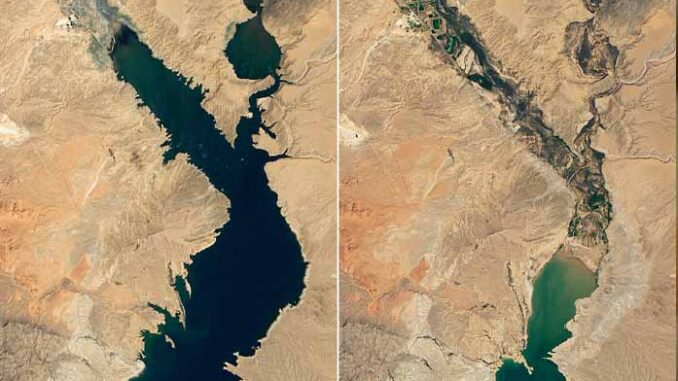
Shocked reactions continue to be expressed following Tuesday’s announcement that the U.S. Department of the Interior’s Bureau of Reclamation will be cutting Arizona’s supply from the Colorado River by 20 percent as of Jan. 1, 2023.
The cutback means Arizona is poised to receive roughly 590,000 less acre-feet of river water in 2023 than this year’s allocation. An acre-foot of water is equal to about 326,000 gallons.
Other actions announced by Bureau of Reclamation include cutting water releases from Lake Powell in an effort to minimize structural damage at the Glen Canyon Dam due to all-time low levels. Such concerns are also behind emergency actions being taken to preserve the water level at Lake Mead to protect the Hoover Dam.
The 1,450-mile Colorado River provides water for 40 million people in several Western states and northern Mexico. It is also used to irrigate over 5 million acres of agriculture land.
Arizona is part of the Lower Basin of the Colorado River. The Bureau’s announcement of cuts comes after a plan proposed by the Arizona Department of Water Resources (ADWR) and the Central Arizona Project (CAP) failed to interest federal water officials.
The Bureau’s plan is also being closely watched by Arizona lawmakers such as Rep. David Cook.
“With some states reluctant to join Arizona and Nevada in making needed cuts, the federal government is going to find itself in the position of making these major decisions for us,” Cook told Arizona Daily Independent. “When that time comes they better treat proactive states like Arizona well, because we’ve been taking steps well in advance of this crisis.”
Cook’s sentiments are shared by two of Arizona’s top water officials who see the Bureau’s plan as insufficient, given that the state has already had its share of Colorado River water significantly reduced.
“It is unacceptable for Arizona to continue to carry a disproportionate burden of reductions for the benefit of others who have not contributed,” according to a statement by ADWR Director Tom Buschatzke and CAP General Manager Ted Cooke.
While the sentiments of Buschatzke and Cooke avoid political overtones, the reactions of some elected officials are raising eyebrows for their hypocritical and self-serving content. Among those is the “disappointment” expressed by U.S. Rep. Greg Stanton about the Colorado River cuts supported by the Biden White House.
“The federal government has failed to offer a plan that requires all states to make the cuts necessary to save the Colorado from system collapse,” said Stanton, a Democrat. “Today’s announcement merely kicks the can down the road and risks turning this crisis into catastrophe.”
Stanton may be calling on the federal government to “play a stronger role” now, but he was not seen as very concerned about water preservation when he served from 2012 to 2018 as the Mayor for the city of Phoenix, or during his eight years on the Phoenix City Council.
Officials in Phoenix have been often criticized for failing to involve all stakeholders in water conservation plans and for pushing “publicity friendly” ideas which do not adequately address long-term planning needs or economic realities.
Another politician being called out for his response to the Colorado River cuts is U.S. Sen. Mark Kelly, who is now demanding the Department of Interior make long-term solutions “an urgent priority,” despite the fact Arizona’s water future has been a top priority for state Republicans for several years.
Earlier this year, Gov. Doug Ducey signed Senate Bill 1740 which provides a $1 billion investment for projects providing additional water for the state. In addition, the governor is currently accepting applications for the Water Infrastructure Finance Authority Board created as part of the legislation.
READ MORE ABOUT WATER BOARD HERE
The problem of how best to preserve water in Arizona, where to get more water, and how to regulate groundwater usage is not only being addressed on a national and state level.
An Aug. 19 court hearing in Cochise County Superior Court will resolve the question of whether about 13,500 registered voters in the southern Sulphur Springs Valley will get a chance to vote on approving or rejecting the creation of a Douglas Groundwater Basin Active Management Area (AMA).
Creation of the proposed Douglas AMA would trigger new regulations for the withdrawal and use of groundwater by private landowners across thousands of acres including the city of Douglas, part of the city of Bisbee, as well as key agriculture communities such as Double Adobe, Elfrida, and McNeal.
An election challenge has been filed by Rural Water Assurance against the petition signatures submitted by proponents of the proposed AMA. The challengers contend the majority of the signatures are deficient and thus the initiative should not appear on the ballot for the 2022 general election.
Rural Water Assurance officials also contend the restrictions which go along with an AMA would interfere with private property rights and negatively impact the value of land within the AMA’s boundaries.
Opponents of the proposed Douglas AMA also point to concerns that it would stifle economic development around the Douglas Port of Entry along the U.S. / Mexico border. The Douglas POE is the second largest in Arizona and is in line for construction of a new $216 million commercial POE to compliment a $184 million renovation project of the current facilities for use as a non-commercial POE.
